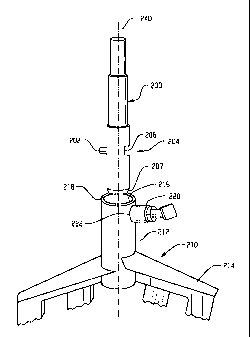Some of the information on this Web page has been provided by external sources. The Government of Canada is not responsible for the accuracy, reliability or currency of the information supplied by external sources. Users wishing to rely upon this information should consult directly with the source of the information. Content provided by external sources is not subject to official languages, privacy and accessibility requirements.
Any discrepancies in the text and image of the Claims and Abstract are due to differing posting times. Text of the Claims and Abstract are posted:
| (12) Patent: | (11) CA 2601947 |
|---|---|
| (54) English Title: | MIXER, MIXING IMPLEMENT AND ASSOCIATED ATTACHMENT MECHANISM |
| (54) French Title: | MELANGEUR, APPAREIL DE MELANGE ET MECANISME DE FIXATION ASSOCIE |
| Status: | Granted and Issued |
| (51) International Patent Classification (IPC): |
|
|---|---|
| (72) Inventors : |
|
| (73) Owners : |
|
| (71) Applicants : |
|
| (74) Agent: | FINLAYSON & SINGLEHURST |
| (74) Associate agent: | |
| (45) Issued: | 2010-05-11 |
| (86) PCT Filing Date: | 2006-02-27 |
| (87) Open to Public Inspection: | 2006-08-31 |
| Examination requested: | 2007-08-20 |
| Availability of licence: | N/A |
| Dedicated to the Public: | N/A |
| (25) Language of filing: | English |
| Patent Cooperation Treaty (PCT): | Yes |
|---|---|
| (86) PCT Filing Number: | PCT/IB2006/050609 |
| (87) International Publication Number: | WO 2006090349 |
| (85) National Entry: | 2007-08-20 |
| (30) Application Priority Data: | ||||||
|---|---|---|---|---|---|---|
|
A mixing implement includes a body having a mixing portion ( (214) and a
connecting portion (212) , the connecting portion having an upper shaft
receiving opening formed therein and a side opening (224) that leads to the
shaft receiving opening, the shaft receiving opening having a drive pin (202)
receiving recess (218) , the side opening and the drive pin receiving recess
located substantially diametrically opposite each other with the side opening
at a height corresponding to at least part of the drive pin receiving recess.
A retainer (50) is movably coupled with the connecting portion through the
side opening and biased into an inward position in which an inner portion of
the retainer is normally positioned within the shaft receiving opening, the
retainer movable to an outward position in which the inner portion of the
retainer is at least partially retracted from the shaft receiving opening.
Appareil de mélange composé d'un corps possédant une partie mélange (214) et une partie accouplement (212). Cette dernière présente une ouverture supérieure conçue pour recevoir une tige et une ouverture latérale (224) conduisant à ladite ouverture. Celle-ci comporte un évidement (218) conçu pour loger un goujon (202) et placé diamétralement opposé à l'ouverture latérale, celle-ci étant située à une hauteur correspondant à au moins une partie de l'évidement recevant le goujon. Un élément de retenue (50) est accouplé mobile à la partie d'accouplement à travers l'ouverture latérale et sollicité dans une position tournée vers l'intérieur dans laquelle une partie intérieure de cet élément est normalement placée à l'intérieur de l'ouverture recevant la tige, cet élément de retenue étant mobile vers une position tournée vers l'extérieur dans laquelle la partie intérieure dudit élément de retenue est au moins partiellement placée en retrait par rapport à l'ouverture de réception de tige.
Note: Claims are shown in the official language in which they were submitted.
Note: Descriptions are shown in the official language in which they were submitted.

2024-08-01:As part of the Next Generation Patents (NGP) transition, the Canadian Patents Database (CPD) now contains a more detailed Event History, which replicates the Event Log of our new back-office solution.
Please note that "Inactive:" events refers to events no longer in use in our new back-office solution.
For a clearer understanding of the status of the application/patent presented on this page, the site Disclaimer , as well as the definitions for Patent , Event History , Maintenance Fee and Payment History should be consulted.
| Description | Date |
|---|---|
| Common Representative Appointed | 2019-10-30 |
| Common Representative Appointed | 2019-10-30 |
| Grant by Issuance | 2010-05-11 |
| Inactive: Cover page published | 2010-05-10 |
| Inactive: Final fee received | 2010-02-22 |
| Pre-grant | 2010-02-22 |
| Notice of Allowance is Issued | 2009-08-24 |
| Letter Sent | 2009-08-24 |
| Notice of Allowance is Issued | 2009-08-24 |
| Inactive: Approved for allowance (AFA) | 2009-08-19 |
| Inactive: Declaration of entitlement - Formalities | 2007-11-19 |
| Inactive: Cover page published | 2007-11-06 |
| Letter Sent | 2007-11-02 |
| Inactive: Acknowledgment of national entry - RFE | 2007-11-02 |
| Inactive: First IPC assigned | 2007-10-23 |
| Application Received - PCT | 2007-10-22 |
| National Entry Requirements Determined Compliant | 2007-08-20 |
| Request for Examination Requirements Determined Compliant | 2007-08-20 |
| All Requirements for Examination Determined Compliant | 2007-08-20 |
| Application Published (Open to Public Inspection) | 2006-08-31 |
There is no abandonment history.
The last payment was received on 2010-02-02
Note : If the full payment has not been received on or before the date indicated, a further fee may be required which may be one of the following
Please refer to the CIPO Patent Fees web page to see all current fee amounts.
Note: Records showing the ownership history in alphabetical order.
| Current Owners on Record |
|---|
| PREMARK FEG L.L.C. |
| Past Owners on Record |
|---|
| JANICE J. SCHNIPKE |
| NEAL H. BLACKBURN |